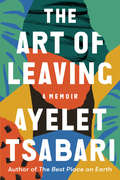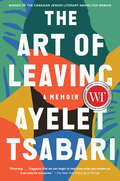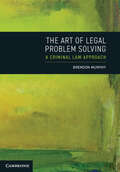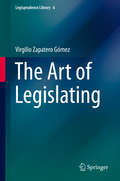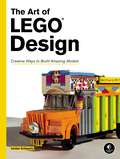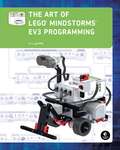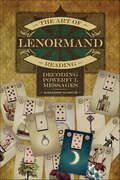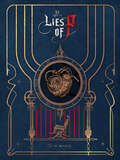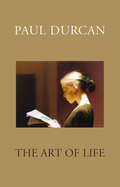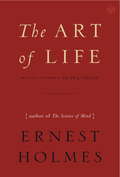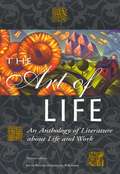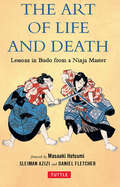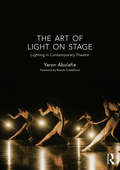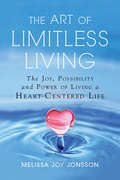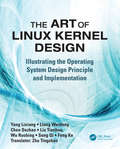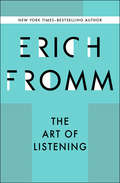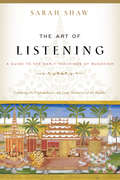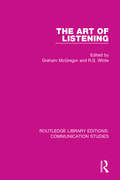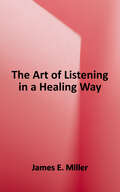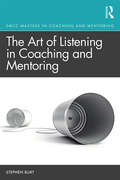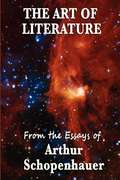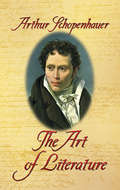- Table View
- List View
The Art of Leaving: A Memoir
by Ayelet TsabariAn intimate memoir in essays by an award-winning Israeli writer who travels the world, from New York to India, searching for love, belonging, and an escape from grief following the death of her father when she was a young girl This searching collection opens with the death of Ayelet Tsabari’s father when she was just nine years old. His passing left her feeling rootless, devastated, and driven to question her complex identity as an Israeli of Yemeni descent in a country that suppressed and devalued her ancestors’ traditions. In The Art of Leaving, Tsabari tells her story, from her early love of writing and words, to her rebellion during her mandatory service in the Israeli army. She travels from Israel to New York, Canada, Thailand, and India, falling in and out of love with countries, men and women, drugs and alcohol, running away from responsibilities and refusing to settle in one place. She recounts her first marriage, her struggle to define herself as a writer in a new language, her decision to become a mother, and finally her rediscovery and embrace of her family history—a history marked by generations of headstrong women who struggled to choose between their hearts and their homes. Eventually, she realizes that she must reconcile the memories of her father and the sadness of her past if she is ever going to come to terms with herself. With fierce, emotional prose, Ayelet Tsabari crafts a beautiful meditation about the lengths we will travel to try to escape our grief, the universal search to find a place where we belong, and the sense of home we eventually find within ourselves.Advance praise for The Art of Leaving “Candid, affecting . . . [Ayelet Tsabari’s] linked essays cohere into a tender, moving memoir.”—Kirkus Reviews (starred review) “Ayelet Tsabari’s memoir is a passionate account of the pain, fire, and fury of adolescence and young adulthood, the search for a sense of belonging, and reconciling the disparate parts of our lives and ultimately ourselves.”—Camilla Gibb, author of This Is Happy and The Beauty of Humanity Movement “Ayelet Tsabari is a fierce-tender writer. Her work is an enchanting mix of vivid anecdote and vigorous insight—spanning generations and geographies, glittering with humor and heart.”—Kyo Maclear, author of Birds Art Life: A Year of Observation
The Art of Leaving: A Memoir
by Ayelet TsabariAn unforgettable memoir about a young woman who tries to outrun loss, but eventually finds a way home. Ayelet Tsabari was 21 years old the first time she left Tel Aviv with no plans to return. Restless after two turbulent mandatory years in the Israel Defense Forces, Tsabari longed to get away. It was not the never-ending conflict that drove her, but the grief that had shaken the foundations of her home. The loss of Tsabari’s beloved father in years past had left her alienated and exiled within her own large Yemeni family and at odds with her Mizrahi identity. By leaving, she would be free to reinvent herself and to rewrite her own story. For nearly a decade, Tsabari travelled, through India, Europe, the US and Canada, as though her life might go stagnant without perpetual motion. She moved fast and often because—as in the Intifada—it was safer to keep going than to stand still. Soon the act of leaving—jobs, friends and relationships—came to feel most like home. But a series of dramatic events forced Tsabari to examine her choices and her feelings of longing and displacement. By periodically returning to Israel, Tsabari began to examine her Jewish-Yemeni background and the Mizrahi identity she had once rejected, as well as unearthing a family history that had been untold for years. What she found resonated deeply with her own immigrant experience and struggles with new motherhood.Beautifully written, frank and poignant, The Art of Leaving is a courageous coming-of-age story that reflects on identity and belonging and that explores themes of family and home—both inherited and chosen.
The Art of Legal Problem Solving: A Criminal Law Approach
by Brendon MurphyThe Art of Legal Problem Solving: A Criminal Law Approach is a sophisticated skills book designed to help students develop the problem-solving techniques necessary for their legal careers. This succinct yet comprehensive book provides the perfect mix of general instruction and specific examples to encourage students to think about problems both in depth and broadly. It follows a clear roadmap presented in a logical progression, beginning with the fundamentals, fact finding and statutory interpretation before turning to the advanced areas of analysing and writing answers to problem questions. While written primarily for criminal law students, the skills imparted are generic and can be applied equally in any area of the law and in any jurisdiction. The Art of Legal Problem Solving is an indispensable work for law students who want to not only improve their problem-solving skills but master them.
The Art of Legislating (Legisprudence Library #6)
by Virgilio Zapatero GómezAny contemporary state presents itself as committed to the “rule of law”, and this notion is perhaps the most powerful political ideal within the current global discourse on legal and political institutions. Despite being a contested concept, the rule of law is generally recognised as meaning that government is bound in all its actions by fixed and public rules, and that these rules respect certain formal requirements and are enforced by an independent judiciary. This book focuses on formal legality and the question of how to achieve good laws—a topic that was famously addressed by the 18th century enlightened thinkers, but also by prominent legal scholars of our time. Historically, the canon of “good legislation” demanded generality, publicity and accessibility, and comprehensibility of laws; non-retroactivity; consistency; the possibility of complying with legal obligations and prohibitions; stability; and congruency between enacted laws and their application. All these are valuable ideals that should not be abandoned in today’s legal systems, particularly in view of the silent revolution that is transforming our legality-based “states of law” into jurisdictional states. Such ideals are still worth pursuing for those who believe in representative democracy, in the rule of law and in the dignity of legislation. The idea for the book stemmed from the author’s parliamentary and governmental experience; he was responsible for the Government of Spain’s legislative co-ordination from 1982 to 1993, which were years of intensive legislative production. The more than five hundred laws (and thousands of decrees) elaborated in this period profoundly changed all sectors of the legal order inherited from Franco’s dictatorship, and laid the foundations of a new social and democratic system. For an academic, this was an exciting experience, which offered a unique opportunity to put the theory of legislation to the test. Reflecting and elaborating on this experience, the book not only increases scholarly awareness of how laws are made, but above all, improves the quality of legislation and as a result the rule of law.
The Art of LEGO Design: Creative Ways to Build Amazing Models
by Jordan SchwartzThe most impressive LEGO models often take careful planning (and lots of pieces), but with some inspiration, a little imagination, and a number of tried-and-true techniques, you too can turn bricks into a masterpiece.In The Art of LEGO® Design, author Jordan Schwartz explores LEGO as an artistic medium. This wide-ranging collection of creative techniques will help you craft your own amazing models as you learn to see the world through the eyes of some of the greatest LEGO builders. Each concept is presented with a collection of impressive models to spark your imagination—like fantastic dragons, futuristic spaceships, expressive characters, and elaborate dioramas.You’ll discover some of the inventive techniques that LEGO artists use to:–Create lifelike creatures from unusual elements like inside-out tires and minifigure capes–Design sleek cars without showing a single stud–Add ambience to dioramas with light bricks or LEDs–Craft eye-catching textures to create cobblestone roads and brick walls–Build sturdy, detailed, posable mechs and other figures–Add depth with forced perspective and interesting silhouettesInterviews with the talented builders behind many of the book’s models reveal their thoughts on the design process and what inspires them most. Even if you’ve been building with LEGO since you could crawl, you’ll find new inspiration in The Art of LEGO® Design.
The Art of LEGO MINDSTORMS EV3 Programming
by Terry GriffinWith its colorful, block-based interface, The LEGO® MINDSTORMS® EV3 programming language is designed to allow anyone to program intelligent robots, but its powerful features can be intimidating at first. The Art of LEGO MINDSTORMS EV3 Programming is a full-color, beginner-friendly guide designed to bridge that gap.Inside, you’ll discover how to combine core EV3 elements like blocks, data wires, files, and variables to create sophisticated programs. You’ll also learn good programming practices, memory management, and helpful debugging strategies—general skills that will be relevant to programming in any language.All of the book’s programs work with one general-purpose test robot that you’ll build early on. As you follow along, you’ll program your robot to:–React to different environments and respond to commands–Follow a wall to navigate a maze–Display drawings that you input with dials, sensors, and data wires on the EV3 screen–Play a Simon Says–style game that uses arrays to save your high score–Follow a line using a PID-type controller like the ones in real industrial systemsThe Art of LEGO MINDSTORMS EV3 Programming covers both the Home and Education Editions of the EV3 set, making it perfect for kids, parents, and teachers alike. Whether your robotics lab is the living room or the classroom, this is the complete guide to EV3 programming that you’ve been waiting for.Requirements: One LEGO MINDSTORMS EV3 Home OR Education set (#31313 OR #45544).
The Art of LEGO Scale Modeling
by Dennis Glaasker Dennis BosmanThe Art of LEGO Scale Modeling displays amazing, fan-built LEGO recreations of real-life vehicles, showing off every amazing detail with high-quality photographs.You'll love poring over dozens of models, including Formula 1 racers, construction vehicles, ships, trains, airplanes, and all kinds of trucks.Authors Dennis Glaasker and Dennis Bosman share their own impressive LEGO models as well as highlight models from builders around the world. The Art of LEGO Scale Modeling also includes tips and tricks that describe the design and building process.
The Art of Lenormand Reading: Decoding Powerful Messages
by Alexandre MusruckWelcome to the world of Lenormand! This system of divination was inspired by Madame Adelaide Lenormand, a well-known psychic at the time of the French Revolution, and was first realized in the late 1700s. This guide will help readers master a style that yields practical advice applicable to today’s world. Receive answers to your most puzzling questions by following simple steps that lead you through each of the 36 cards. Learn to work with spreads that will take you from beginning layouts to the famed revealing of the 8 keys that unlock the Grand Tableau, which uses all the cards in one spread for an in-depth reading. Identify and understand the symbolism of regular playing cards; find out the physical attributes of people identified in your readings; learn about love, health, money, time, and more. Can be used with any Lenormand deck.
The Art of Lies of P
by NEOWIZ ROUND8 StudioAn oversized full-color art book chronicling the making of the hit video game.Geppetto&’s puppet is trapped in a web of lies. Fierce monsters and devious figures stand between the would-be real boy and the truth: who unleashed the plague that has plunged the once prosperous city of Krat into madness and blood lust?In Lies of P, an embattled puppet must adapt his weapons and his body to face untold horrors, untangle unfathomable secrets, and confront the consequences of both honesty and deceit.Dark Horse and ROUND8 Studio invite readers to explore this mysterious and thrilling world through a lovingly assembled collection of concept art, accompanied by intimate creator commentary. The Art of Lies of P is a darkly fantastic journey through the creation of the video game sensation.
The Art Of Life
by Paul DurcanIn The Art of Life Paul Durcan takes us around County Mayo in his "filthy, two-door, bottle-green Opel Astra", stopping off at Westport and Achill Island, where he declares himself to be "globally sad", but "locally glad". Next he travels east to Dublin to hold in his arms his newborn granddaughter and thence to Tuscany, Poland and Japan. Along the way he reflects upon parental pride, the aches and pains of old age, the trim bottoms of snooker players, the wisdom of ex-wives and dogs on Sandymount Strand, while introducing us to a host of colourful characters, including a bishop, a roofer, a milkman, a priest and an unmarried mother. Is there an art of living or is life a work of art? This magnificent collection - originally published on Paul Durcan's sixtieth birthday - reveals one of Ireland's most successful and popular poets at the height of his powers and continuing to challenge, amuse and delight.
The Art of Life
by Ernest HolmesThe inspiration of Ernest Holmes has reached hundreds of thousands of readers through his classic works, many of which are just now becoming available in paperback. Originally published in the first half of the twentieth century, these meditative, concise volumes have never previously appeared in paperback. Whether a newcomer to the philosophy Holmes founded or a veteran reader, you will find great power and practicality in the words that render Holmes one of the most celebrated and beloved mystical teachers of the past hundred years.
The Art of Life: An Anthology of Literature about Life and Work
by Christine LaroccoThe Art of Life is an anthology of literature that focuses on the personal qualities that are the foundation of success in life and work. More than fifty literature selections are organized by themes such as honesty, initiative, respect, and adaptability that represent attitudes and characteristics for success.
The Art of Life and Death
by Sleiman Azizi Masaaki Hatsumi Daniel Fletcher[Daniel Fletcher and Sleiman Azizi studied ninjutsu under the tutelage of the venerable Masaaki Hatsumi of the Bujinkan Dojo and in The Art of Life and Death, they pay homage to their Sensei by revealing a host of insightful discoveries. As is the tradition in Eastern disciplines, these lessons are conveyed in stories, poetry, art and proverbs. Their words of wisdom about the nature of life and death will provoke thought and perhaps break through certain obstacles in your own life that prevent you from achieving transformation.]There is a Japanese proverb that admonishes a student not to step on the shadow of his teacher. In writing this book, Fletcher and Azizi discovered that no matter how hard they tried to avoid stepping on it, their teacher's shadow was always there-a reminder of his influence on their lives while at the Bujinkan Dojo. And so, while The Art of Life and Death relates their own personal discoveries, it is also a testament to the vitality of the grandmaster and his budo teachings.
The Art of Life and Death
by Masaaki Hatsumi Daniel Fletcher Sleiman Azizi[Daniel Fletcher and Sleiman Azizi studied ninjutsu under the tutelage of the venerable Masaaki Hatsumi of the Bujinkan Dojo and in The Art of Life and Death, they pay homage to their Sensei by revealing a host of insightful discoveries. As is the tradition in Eastern disciplines, these lessons are conveyed in stories, poetry, art and proverbs. Their words of wisdom about the nature of life and death will provoke thought and perhaps break through certain obstacles in your own life that prevent you from achieving transformation.]There is a Japanese proverb that admonishes a student not to step on the shadow of his teacher. In writing this book, Fletcher and Azizi discovered that no matter how hard they tried to avoid stepping on it, their teacher's shadow was always there-a reminder of his influence on their lives while at the Bujinkan Dojo. And so, while The Art of Life and Death relates their own personal discoveries, it is also a testament to the vitality of the grandmaster and his budo teachings.
The Art of Lifestyle
by K. V. S. Rao"The Art of Lifestyle" by K Vikram Simha Rao explores the profound impact of lifestyle choices on our overall well-being. Drawing from ancient Indian sciences like Ayurveda, Yoga, and Naturopathy, the author emphasizes preventive measures over curative ones to foster physical and mental health. The book covers a broad spectrum of topics, from the benefits of good health and body cleansing to cooking, food habits, and the role of natural elements like air, water, and sunlight. It also delves into the influence of technology on modern lifestyles, advocating for a balanced approach that includes physical activity, proper rest, and mindful eating. Rao’s practical insights aim to inspire readers to adopt self-regulating, rational lifestyles for long-lasting health and happiness. The book is dedicated to enriching lives through these ancient practices, aiming to minimize pain and medical expenses while maximizing overall health and social well-being.
The Art of Light on Stage: Lighting in Contemporary Theatre
by Yaron AbulafiaThe Art of Light on Stage is the first history of theatre lighting design to bring the story right up to date. In this extraordinary volume, award-winning designer Yaron Abulafia explores the poetics of light, charting the evolution of lighting design against the background of contemporary performance. The book looks at the material and the conceptual; the technological and the transcendental. Never before has theatre design been so vividly and excitingly illuminated. ? The book examines the evolution of lighting design in contemporary theatre through an exploration of two fundamental issues: ? 1.?????? What gave rise to the new directions in lighting design in contemporary theatre? 2.?????? How can these new directions be viewed within the context of lighting design history? ? The study then focuses on the phenomenological and semiotic aspects of the medium for light – the role of light as a performer, as the medium of visual perception and as a stimulus for imaginative representations – in selected contemporary theatre productions by Robert Wilson, Romeo Castellucci, Heiner Goebbels, Jossi Wieler and David Zinder. ? This ground-breaking book will be required reading for anyone concerned with the future of performance.
The Art of Limitless Living: The Joy, Possibility and Power of Living a Heart-Centered Life
by Melissa Joy JonssonWe already are what we wish to become. Join inspiring, life-transformational leader Melissa Joy on a journey to the heart of interactive reality creation, where self-love is the new normal. Humanity is in a position that we have never been in previously, on new and unfamiliar terrain. You may be at a place in your own life where you are aware that “tried and true” behaviors and beliefs are no longer working. You may be unsure how to proceed. <P><P>Through a brilliant weave of unique language, testimonials, and practical play, The Art of Limitless Living provides multiple access points for creating new self-loving maps to navigate through changing landscapes. <P><P> In The Art of Limitless Living, you will learn: Why the notion that we create our own reality is only half true.Why heart-centered awareness is key to self-love, authenticity, completion, and transcending your stories.How to bridge the gap between limitless potential and limitation.How to leverage placeholders, heart-mind synthesis, and fluid boundaries.How to overcome problems with family, friends, work, and society.How to apply equal service to self and others to change prevailing paradigms.How to transcend addictions and distractions.How curiosity can transform predictability into possibility and create a new reality, right now.
The Art of Linux Kernel Design: Illustrating the Operating System Design Principle and Implementation
by Lixiang YangUses the Running Operation as the Main Thread Difficulty in understanding an operating system (OS) lies not in the technical aspects, but in the complex relationships inside the operating systems. The Art of Linux Kernel Design: Illustrating the Operating System Design Principle and Implementation addresses this complexity. Written from the perspective of the designer of an operating system, this book tackles important issues and practical problems on how to understand an operating system completely and systematically. It removes the mystery, revealing operating system design guidelines, explaining the BIOS code directly related to the operating system, and simplifying the relationships and guiding ideology behind it all. Based on the Source Code of a Real Multi-Process Operating System Using the 0.11 edition source code as a representation of the Linux basic design, the book illustrates the real states of an operating system in actual operations. It provides a complete, systematic analysis of the operating system source code, as well as a direct and complete understanding of the real operating system run-time structure. The author includes run-time memory structure diagrams, and an accompanying essay to help readers grasp the dynamics behind Linux and similar software systems. Identifies through diagrams the location of the key operating system data structures that lie in the memory Indicates through diagrams the current operating status information which helps users understand the interrupt state, and left time slice of processes Examines the relationship between process and memory, memory and file, file and process, and the kernel Explores the essential association, preparation, and transition, which is the vital part of operating system Develop a System of Your Own This text offers an in-depth study on mastering the operating system, and provides an important prerequisite for designing a whole new operating system.
The Art of Listening
by Erich FrommThe renowned social psychologist and New York Times–bestselling author shares his insights on the process of psychotherapy, drawing on his own experience. Over the course of a distinguished career, Erich Fromm built a reputation as a talented speaker and gifted psychoanalyst—the first specialization of this polymath. The Art of Listening is a transcription of a seminar Fromm gave in 1974 to American students in Switzerland. It provides insight into Fromm&’s therapy techniques as well as his thoughts and mindset while working. In this intimate look at his profession, Fromm dismantles psychoanalysis and then reassembles it in a clear and engaging fashion. This ebook features an illustrated biography of Erich Fromm including rare images and never-before-seen documents from the author&’s estate.
The Art of Listening: A Guide to the Early Teachings of Buddhism
by Sarah ShawAn accessible introduction to the teachings of the Buddha told through the oral tradition of the Dīghanikāya--the preeminent text of the Pali canon.The Dīghanikāya or Long Discourses of the Buddha is one of the four major collections of teachings from the early period of Buddhism. Its thirty-four suttas (in Sanskrit, sutras) demonstrate remarkable breadth in both content and style, forming a comprehensive collection. The Art of Listening gives an introduction to the Dīghanikāya and demonstrates the historical, cultural, and spiritual insights that emerge when we view the Buddhist suttas as oral literature. Each sutta of the Dīghanikāya is a paced, rhythmic composition that evolved and passed intergenerationally through chanting. For hundreds of years, these timeless teachings were never written down. Examining twelve suttas of the Dīghanikāya, scholar Sarah Shaw combines a literary approach and a personal one, based on her experiences carefully studying, hearing, and chanting the texts. At once sophisticated and companionable, The Art of Listening will introduce you to the diversity and beauty of the early Buddhist suttas.
The Art of Listening: The Creative Hearer In Language, Literature And Popular Culture (Routledge Library Editions: Communication Studies #8)
by R. S. White Graham McGregorOriginally published in 1986. This collection of essays is unified by one leading idea: that the active and creative abilities of listeners and readers deserve as much attention as the skills of speakers and writers. It is shown that hearers, far from being passive recipients in the communicative process, are in fact active in selecting, interpreting and creating from the disparate signals they receive. Equally, readers are involved in creating individual patterns of significance from a text. In presenting this argument, some essays deal with the importance of gender considerations, some with special modes of writing such as the private diary and literary translations, and others with the more familiar fields of poetry and drama. In the sphere of popular music, distinctions such as ‘folk’ and ‘pop’ indicate special problems in assessing the ‘authenticity’ of a listener’s response. By concentrating on active listening, the collection develops and illustrates the conviction that there are fundamental premises underlying the various disciplines under review, the analysis of which makes for a fuller understanding of communication in all its forms.
The Art of Listening in a Healing Way
by James E. MillerThe Art of Listening in a Healing Way is Jim Miller's sequel to his popular book, "The Art of Being a Healing Presence." He describes what healing listening is and how it differs from other kinds of listening. Then 27 short chapters provide helpful insights into how to do this special kind of listening. Examples: "A healing listener listens with the eyes." "A healing listener cleaves to silence." Interspersed throughout are intriguing quotations from the ages, as well as the author's floral photography.
The Art of Listening in Coaching and Mentoring (Routledge EMCC Masters in Coaching and Mentoring)
by Stephen BurtThis book answers a number of fundamental questions about listening in coaching and mentoring. What difference does being heard make to the speaker? How does it have that effect? What are the necessary components of good listening? How do you evaluate your practice as a listener and how do you improve? The process of writing this book led the author to look closely at his own practice, test, experiment, and push his listening to a higher level. He invites the reader to do the same. This book identifies what it takes to listen well – the skills, mind-set, presence, self-awareness and self-management – and why it can be hard. It demonstrates how four modes of listening – attention, inquiry, observation and use of self – all contribute to the listener’s understanding and to the speaker’s awareness. It argues that we all have a ‘learning edge’ as listeners and provides a framework that helps each of us find it. The book is intended as a companion for anyone who commits to becoming a good listener. It shows how to develop expertise in the four modes of listening. It offers examples and principles to guide practice, questions for reflection, and a series of ‘workouts’ to help the listener develop their ability to listen. It encourages by showing how good listening is simple – you turn up, pay attention, and listen with all you have, and it challenges by identifying the work it takes to do that.
The Art of Literature
by Arthur SchopenhauerCollected here are eight short essays-- On Authorship, On Style, On the Study of Latin, On Men of Learning, On Thinking for Ones Self, On Criticism, On Reputation, On Genius-- by the world renowned philosopher Arthur Schopenhauer.
The Art of Literature
by Arthur Schopenhauer T. Bailey SaundersThe great pessimist who believed in the best and expected the worst from writers here applies his caustic wit to literature and the literary scene. Schopenhauer's piercing analyses of style, critics, literary values, learning, and genius make this volume a handbook on writing ― illuminated by the author's own shining, powerful style. The best way to discover the finest qualities of style and to form a theory of writing, he advises, is not to follow a trendy mannerism, but to study the ways in which great authors executed their best work. Schopenhauer provides excellent examples for aspiring writers in this collection of essays from his celebrated work Parerga. Translated by T. Bailey Saunders.
